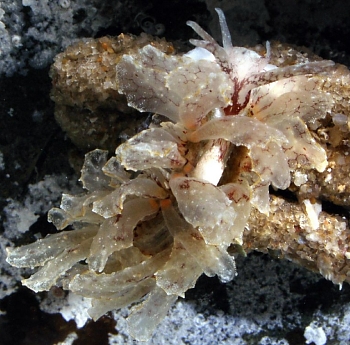
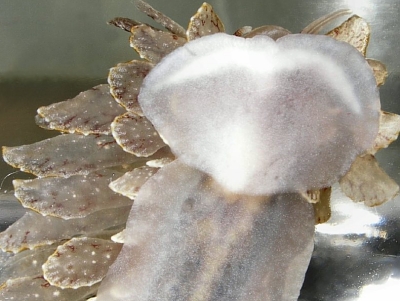
Cyerce sp. 4
Order: SACOGLOSSA
Superfamily: LIMAPONTIOIDEA
Family: Caliphyllidae
DISTRIBUTION
Known at present from sthn Queensland and nthn New South Wales, eastern Australia.
PHOTO
Locality: Hastings Point, 1 metre, New South Wales, Australia, Pacific, 30 January 2007, Under rock on rock reef, low tide. Length: 30mm. Photographer: Denis Riek.
Similar in ceratal shape and colour to Polybranchia orientalis but differs in having foot divided into two parts. The cerata are thin and tranlcent clear with some brown reticulate patterning and scattered slightly raised whitish pustules. Some traces of yellowish brown around edge of cerata.
Authorship detailsRudman, W.B., 2008 (September 15) Cyerce sp. 4 [In] Sea Slug Forum. Australian Museum, Sydney. Available from http://www.seaslugforum.net/find/cyersp4
Related messages
Cyerce cf. pavonina found sthrn Queensland
September 15, 2008
From: Gary Cobb
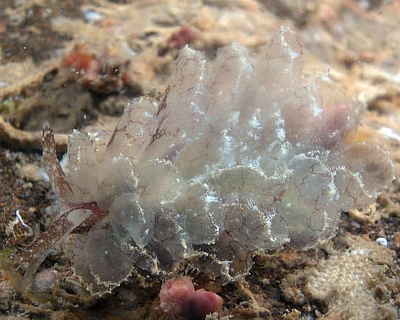
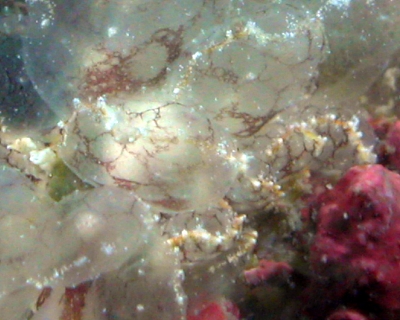
Hi Bill and everyone!
While diving last November, I happened to turn over a rock and there was this beautiful Cyerce cf. pavonina. I have in the past found Cyerce in rather shallow water or intertidal. To find this one in 14 m of water is quite a treat.
I have included two in situ photos One taken by me and one taken by David Mullins. I also included a ventral view showing the characteristic transverse groove.
Locality: Old Woman Island, Mooloolaba, Sunshine Coast, 14 mm, Queensland, Australia, Pacific Ocean, 03 November 2007, Subtidal. Length: 38 mm. Photographer: Gary Cobb and David Mullins.
Cheers
Gary Cobb
gary@nudibranch.com.au
Cobb, G.C., 2008 (Sep 15) Cyerce cf. pavonina found sthrn Queensland. [Message in] Sea Slug Forum. Australian Museum, Sydney. Available from http://www.seaslugforum.net/find/21095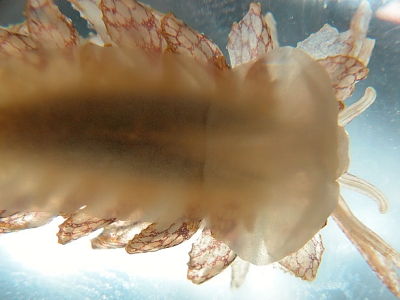
Dear Gary,
Thanks for this nice find. It is obviously the same species as Denis Riek's [message #19461] which I tentatively placed with Cyerce sp. 1, but with more material seems rather different. It also looks as though Cyerce sp. 3 is the same as Cyerce sp. 1 so that it looks as though some 'housekeeping' will need to be done by me.
As I said to Denis, if I hadn't seen the transverse groove in the sole of the foot I would have identified this as Polybranchia orientalis. What does puzzle me is why a number of websites identify your animal as Cyerce cf. pavonina when it has none of the characteristic features of that species. I have added a new Fact Sheet to show the essential features of that species.
Concerning your species, I know it is boring, but I think I should call it Cyerce sp. 4.
Just as a general point to everyone, When I use names like Cyerce sp. 4, and Cyerce cf. kikutarobabai, they have no official meaning and if you use them elsewhere it is important to add a reference to Rudman and the Sea Slug Forum so that if a reader sees the name somewhere he can check out what it means. I use 'cf' in a name just as a shorthand way to link an animal to a species it has some resemblance to. It doesn't mean I necessarily think it is closely related to the actual species, it just is a way to remind me -and you I hope - that it has something in common.
Best wishes,
Bill Rudman
Cyerce sp from nthn New South Wales
June 28, 2007
From: Denis Riek
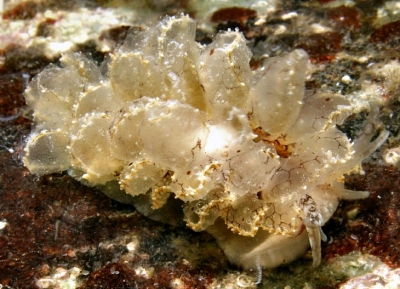

Note added 15 September 2008: I have moved this to Cyerce sp. 4 .
Dear Bill,
Here are some images of a Cyerce sp found at Hastings Point, Northern New South Wales. It was found just below low tide and is the first I have seen at this spot. It is quite a delicate looking animal for a habitat that receves plenty of wave action.
Locality: Hastings Point, 1 metre, New South Wales, Australia, Pacific, 30 January 2007, Under rock on rock reef, low tide. Length: 30mm. Photographer: Denis Riek.
Also I have finally gone on line with a site that focuses on Sea Slugs and other marine invertebrates from Northern New South Wales - http://www.roboastra.com
Cheers
Denis
dwriek@optusnet.com.au
Riek, D.W., 2007 (Jun 28) Cyerce sp from nthn New South Wales. [Message in] Sea Slug Forum. Australian Museum, Sydney. Available from http://www.seaslugforum.net/find/19461
Dear Denis,
When I first saw your photo I thought of Polybranchia orientalis, but as your photo of the underside shows, the anterior part of the foot is separated from the rest of the foot which is a character of Cyerce. Another difference between the two is the lack of digestive gland branches in the cerata of species of Cyerce which is also the case in your animal. The brown branching we can see in your photos is a pigment pattern on the skin which links it to the animal I am calling Cyerce sp. 1. Although the pattern is not so complete in your animal I suspect that is what it is.
Best wishes,
Bill Rudman
